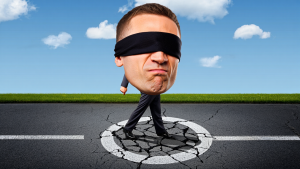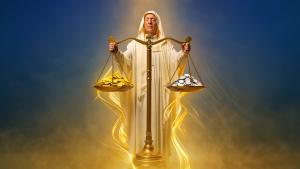The Collective Mindset Is a Trap: Why Most Investors Get Wrecked at Turning Points
May 3, 2025
“The Crowd Always Loses—From Ancient Philosophers to Warren Buffett, History Proves Panic Is a Signal to Buy”
The April Panic That Proved the Crowd Still Doesn’t Learn
From April 2 to April 7, markets melted like butter on a hot skillet. Headlines screamed “Sell-off,” sentiment surveys plunged, and once-confident bulls turned into sheep fleeing a thunderstorm. Fear was contagious. But here’s the punchline: April 9 saw a violent melt-up that only happens when the crowd is caught leaning the wrong way. Since then, we’ve trended higher, not because the world suddenly fixed itself, but because the crowd was again wrong at the worst moment. That’s not just a coincidence. It’s the pattern.
This brief window proves what market historians and contrarians have always known: panic is a signal, not to run, but to buy. The best trades are made when burros are braying in fear, not when CNBC pats your back. Never follow the masses. Their job is to lose.
The Collective Mindset Trap: Why Most Investors Lose Together
Ever wonder why markets soar on euphoria and crash on panic like clockwork? It’s not just algorithms or data. It’s something deeper, primal, and predictable. The collective mindset is the psychological echo chamber where rationality dies and bubbles are born.
This isn’t new. From Aristotle’s warnings to Buffett’s billions, thinkers across centuries have tried to warn us: the crowd is almost always wrong at the worst possible time.
Let’s break it down—through ancient wisdom, brutal market crashes, and two unforgettable real-world case studies.
Ancient Warnings: Aristotle, Seneca, and the Madness of Many
Aristotle saw it early. He called out the emotional sway of the masses—how people abandon logic when swept into groupthink. Democracy? Fine. Mob rule? Deadly. In “Politics,” he warns us that emotional crowds empower manipulators, not truth-seekers.
Seneca, Rome’s stoic heavyweight, echoed: “The most powerful is he who has himself in his power.” Translation? The minute you follow the herd, you’ve already lost.
The Psychology of the Herd: Why Following the Crowd Will Cost You Everything
The Madness of Crowds isn’t just a relic of history—it’s alive and well today. From Charles Mackay’s “Extraordinary Popular Delusions” to Gustave Le Bon’s “The Crowd,” we’ve long known that the crowd is often wrong, and those who follow it are doomed to fail.
Mackay’s 1841 classic uncovered the truth behind the madness of the Dutch Tulip Mania and the South Sea Bubble. His conclusion? When people get caught in a wave of collective thinking, they stop thinking at all. Emotion, not logic, drives their decisions. And where does that lead? A meltdown. A crash. A loss. All are wrapped up in an illusion of safety that vanishes when reality hits.
Le Bon took it even further, declaring that crowds have a collective mind, a force that overrides individual thought. It’s impulsive. It’s irrational. And it’s a breeding ground for disastrous financial decisions. Sound familiar?
Think about April 2023. The markets were in a panic. But while the crowd was rushing for the exits, the true opportunity was in front of us. The market’s chaos was the perfect stage for the contrarian investor to step in and buy what others were selling in fear. The crowd was wrong—again.
Buffett’s Secret Weapon: Seeing What Others Can’t
Warren Buffett has mastered the art of ignoring the crowd. During the 2008 financial crisis, when panic gripped the market and sell-off headlines blared from every screen, most investors ran for cover, pushing stock prices to bargain levels. But not Buffett. He leaned in. He saw what others couldn’t see: opportunity. By buying undervalued assets, he emerged victorious while the rest suffered.
Fast-forward to April’s panic: the same script played out. From April 2–7, the market melted down, sentiment surveys plunged, and fear drove traders to sell. Then came that violent April 9 melt-up—proof that mass fear often signals the exact bottom. Like in 2008, Buffett’s approach would have been to ignore the noise, buy when others panic, and let time do the heavy lifting.
Buffett’s secret isn’t just picking the right companies. It’s understanding the collective mindset—recognising that mass fear distorts prices and creates an edge. Remember Coca-Cola in the 1980s? While investors bailed, Buffett saw the brand’s true potential. His patience and calm in the eye of the storm made him millions.
The point? Buffett doesn’t follow the herd. He sees opportunity in panic. Markets don’t reward the masses—they reward those who stand alone and wait for the dust to settle.
Real-World Examples: Dot-Com Mania and the $100 Hot Sauce
Let’s go from macro to micro:
1. Dot-Com Bubble (1995–2000):
Everyone thought the internet would print money forever. Valuations hit absurd levels. Investors chased logos, not profits. Then it all collapsed. Hundreds of companies have gone. Portfolios wrecked. The collective mindset lit the fuse.
2. Sriracha Shortage (2023):
Hot sauce turned into liquid gold. Bottles flipped for $100. Why? Scarcity met social frenzy. Logic left the room. The sauce was the same, but the perception changed. That’s how fast the crowd distorts value.
The Cost of Consensus: Why the Masses Get It Wrong Every Time
The truth is, the fallacy of consensus in markets has been proven repeatedly. Whether it’s in the crash of 2000 or the dot-com bubble, the crowd’s behaviour is often a warning sign. When everyone thinks the same way, the best move is to go the other direction. History proves it. The collective mindset leads to bubbles, crashes, and missed opportunities for those who think for themselves.
If you’re going to survive in the market, you need to be the one who steps in when others panic. Ignore the herd, trust your instincts, and make decisions based on data and logic. The best trades are made in fear, not greed. And the mass panic? It’s your signal to buy.
Final thoughts
The greatest threat to your portfolio isn’t inflation, interest rates, or global wars. It’s a consensus.
When you move with the crowd, you’re already late. You’re not an investor—you’re a follower.
Learn from Aristotle. From Mackay. From Buffett. Watch the crowd, but never follow it.
In markets, the collective mindset doesn’t think—it reacts. And that’s where the edge lives: outside the echo chamber.
Inspiring Ideas: Spark Fresh Thinking













